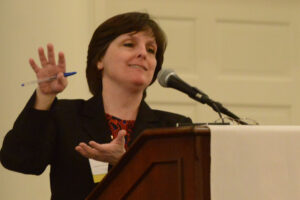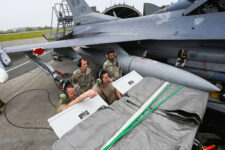
NATIONAL DEFENSE UNIVERSITY: Like a surgeon planning to separate Siamese twins, Pentagon officials worry how complex the congressional mandated breakup of the acquisition bureaucracy could become.
“We understand the challenges (and are) very cognizant” of the risk,” acting deputy assistant secretary for research and engineering Mary Miller told me this morning.

Mary Miller
“It’s going to be difficult,” Miller said at a National Defense Industrial Association conference here, “but we’ve never had a better opportunity in the two decades, three decades that I’ve been in the business” to reform a sclerotic acquisition system.
Pressed for details, Miller declined. “I can’t tell you an awful lot because the secretary has not released it to Congress and they get the first chance to look at it,” she said. The Pentagon must submit its plan to the Hill this August and implement it by February.
Miller acknowledged the uncertainty took its toll. “The work force is uncomfortable. They don’t know what it means, and we haven’t been able to tell them much, because the secretary is still saying, ‘do I like this plan, do I not like this plan?’ (And) the secretary has been excruciatingly busy.” In other words, it’s not just too early to discuss details; the details are still very much in flux.
That said, work is underway. There’s “a small cross-functional team that was assembled to work on the….” — Miller searched for the right word before settling delicately on “opportunity.” This team is now working through which parts of the current Acquisition, Technology, & Logistics (ATL) organization will go to the new Defense Undersecretary for Research & Engineering (R&E) and which ones will go to the Defense Undersecretary for Acquisition & Sustainment (A&S). “We were also asked by the staff (in Congress) to make sure it wasn’t just an org chart moving of boxes,” she said, but a thoughtful rethink of the entire system. Senate Armed Services chairman John McCain, famous for his denunciations of acquisition failures, who led the charge to split up ATL, ably accompanied by the veteran SASC staffer Bill Greenwalt.

Sen. John McCain and Rep Mac Thornberry, chairmen of the Senate and House Armed Services Committees
There is a real risk in splitting the people who invent and develop new weapons — the research & engineering side — from the people who buy, deploy, and support them — acquisition & sustainment. Even with a single undersecretary focused on the challenges, weapons development is still notorious for what some call the “valley of death” — a promising technology comes out of the labs but never makes it into the field because the acquisition side did not pick up where the developers left off. Conversely, developers are often criticized for creating wonder weapons that can’t be bought in bulk or sustained in the field at an affordable price.
Coordinating these two communities may only get harder once they report to different bosses. In fact, the Pentagon used to have an independent undersecretary for research and engineering, but that position was folded under what became ATL to improve coordination — a reform the current legislation would reverse.
“There’s a natural tension, because one’s all about taking risk and one’s all about mitigating risk,” Miller said. The undersecretary of research & engineering will pursue new technologies to make sure the US military stays on top of rapidly advancing adversaries — an inherently uncertain enterprise. Acquisition & sustainment will focus on making sure military materiel is affordable, efficient, and fielded as fast as and effectively as possible — which is all about reducing uncertainty.
In fact, one of the arguments for the split is that research requires a different mindset, even a different institutional culture, than acquisition. “The creation of these two new unders gives us an incredible opportunity to (advance) this culture change,” Miller said. “It’s a great strategy. It’s exceptionally challenging to implement, as you might imagine.”
Navy is down $1B in munitions from ops in Red Sea, says SECNAV
The dollar figure from the secretary comes as Speaker of the House Rep. Mike Johnson said he is ready to bring the supplemental funding bill the Navy needs passed to the floor for a vote.


























